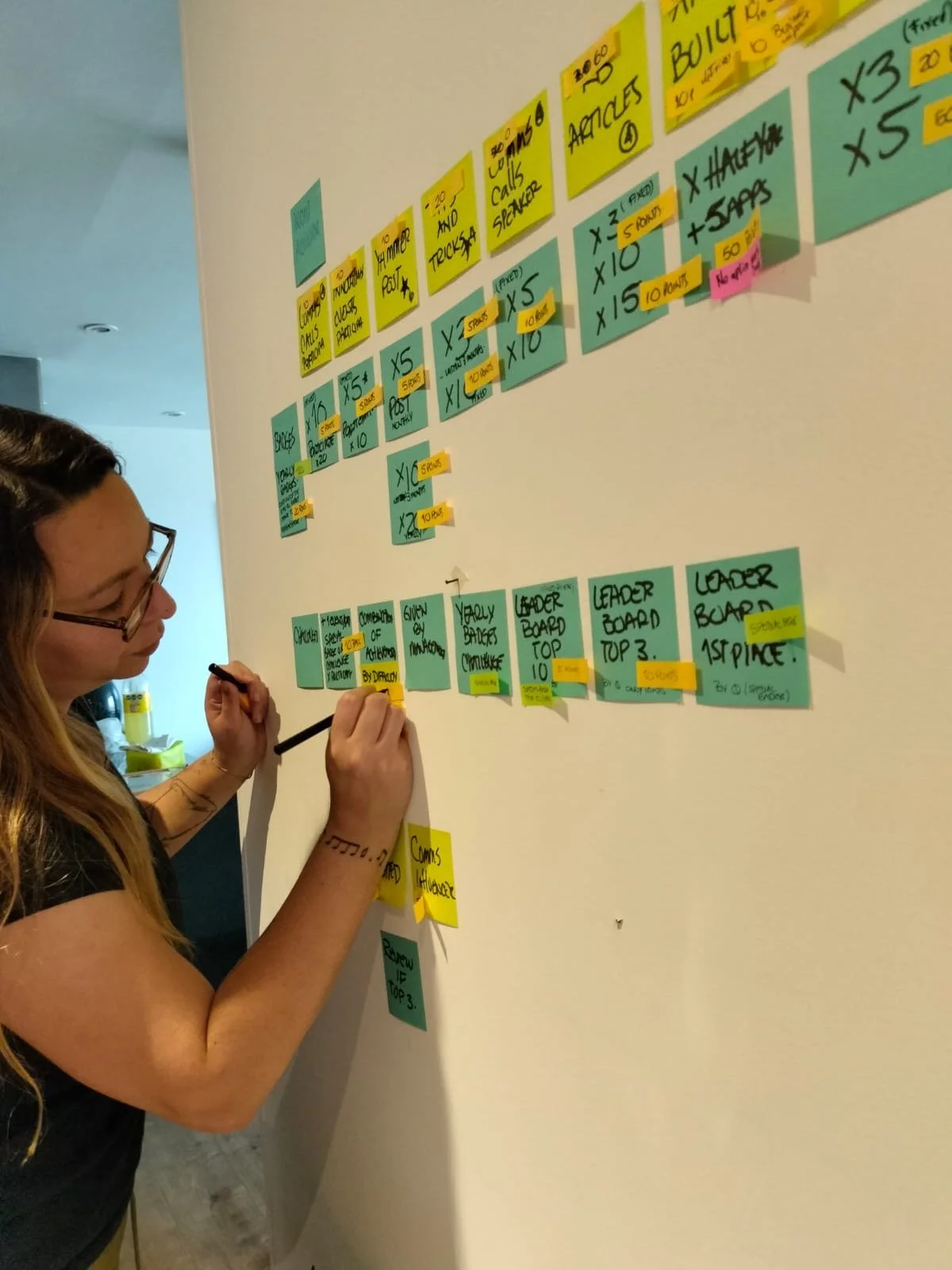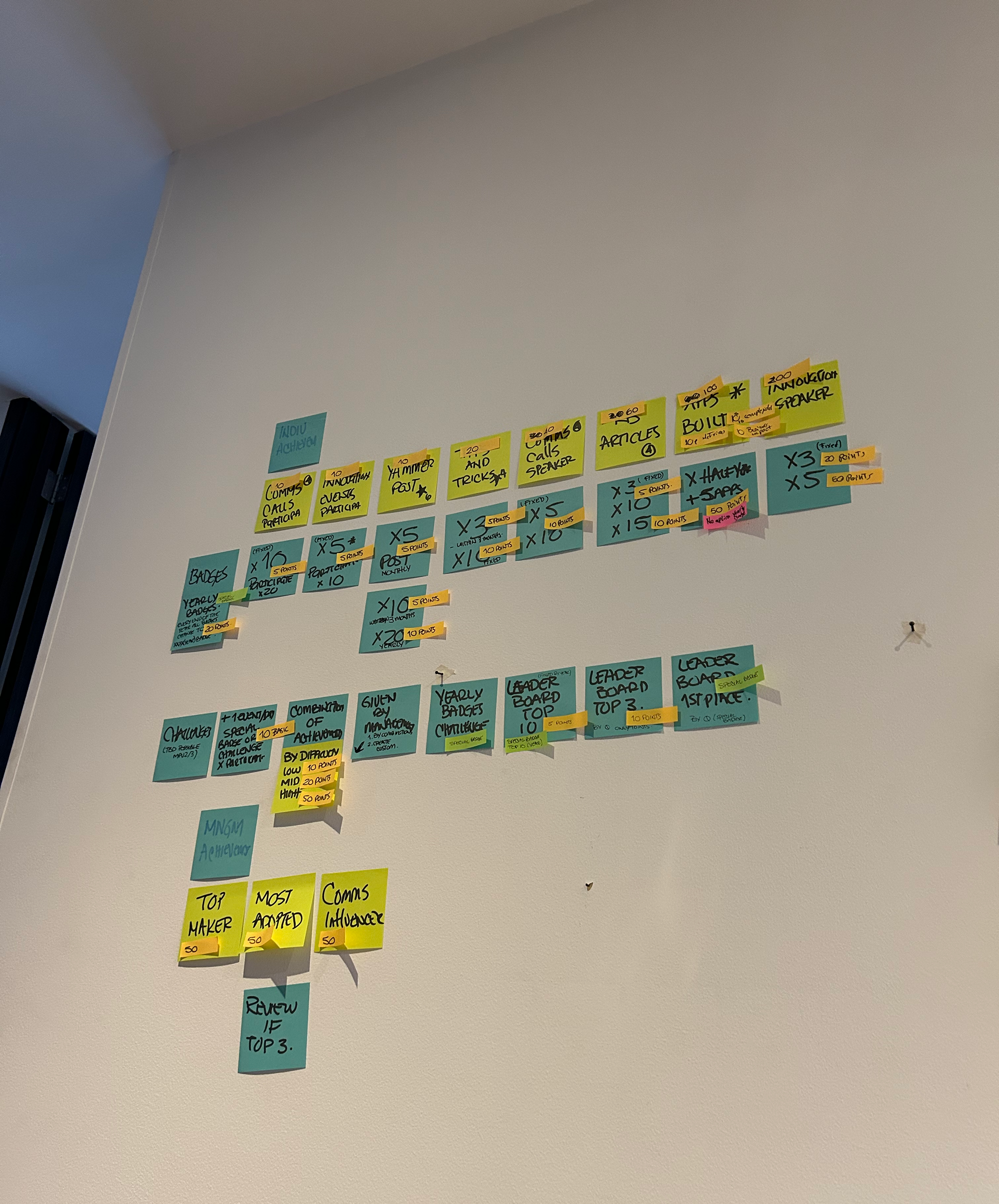Case Study
The Digital Crusade
A gamified app for employee achievement recognition
Companies often talk about gamification, but what does that really mean? And how can companies apply it to engage their employees?
First, jump into the Delorean with me and let’s take a look at a past story…
I have always been a board-game lover, fascinated by how game dynamics can positively impact skill development. Curious about this topic and with the idea of starting my own business, I began learning about it in 2019. I read (a lot) and took several online and in-person certifications to fully understand how this methodology could be applied to teams and skill development.
Gamification means to “apply game elements and principles in non-game contexts to motivate and engage people.” Sounds easy, doesn’t it? But implementing it in a business environment, which is often very serious, is not that simple. I didn’t want to do the same as “all companies” did—build an app with a leaderboard, encourage competition, points, etc. (which is funny because the case study I worked on and will present briefly is precisely that). But for my own project, I wanted something different and meaningful for work teams.
So, in mid-2019, Storynauts was born (my own business). I worked with schoolteachers, psychologists, and project managers. Together, we designed a gamification space using board games and other customized games to foster creativity and teamwork. We closely observed behaviors to identify soft skills like communication, leadership, planning, and more while people played. It was a hit! We were active in around six companies, planned our own workshops, and participated in several entrepreneur events. It was awesome! But then the pandemic came, and we needed to stop. Sadly, that was the end of Storynauts.
All that story was to introduce my experience and knowledge in using gamification in business environments. Since this is a topic I love and enjoy, every time I have the opportunity to be involved in a project that might apply this method, I jump into it!
Once upon a time in the Digital Cells…
Digital Cells is a division within the Digital Portfolio of the company. They are a team of 25 leads dedicated to supporting and building apps for specific functions, divisions, and regions. Most of these team members also work in different divisions and projects outside the Cells at the same time, making their participation in the Cells somewhat voluntary. This represents a challenge for engagement in special projects, events, and collaboration within the Digital Community.
With this challenge in mind, the Digital Cells Manager, aware of my experience with gamification, reached out to me with the idea of building an app to recognize leads and their team’s participation by recognizing individual achievements through a gamified app. The existing methods of recognition lacked visibility and impact, necessitating a more engaging and rewarding system.
Press start to play
To fully understand the Cells’ needs, I facilitated a Design Thinking workshop with key business stakeholders (Digital Cells leaders). Together with the Digital Cells Manager, we did pre-work to identify possible initial achievements as a starting point to work with the leads. The workshop exercises were custom-designed based on Design Thinking methods such as the Creativity Matrix and the Importance/Difficulty Matrix, with the goal of identifying achievements to be rewarded, their rules of accomplishment, and their importance.
This collaborative approach allowed us to gather valuable insights into what motivated employees and how recognition could be effectively gamified.
Building the point system
Using insights from the workshop, I started by analyzing and streamlining the final achievements to include in the app. As a result of the workshop activities, I was also able to identify the importance and potential value of those achievements, allowing me to design the point system.
I’m a very visual person, so as much as digital tools are great, in my design process, I always like to write, draw, and use sticky notes to visualize on paper what I’m working on before jumping into the computer. I cleaned up my studio walls and started using sticky notes to visualize and map the app elements (achievements, points, badges, and challenges) on the wall, moving them around and having a big picture of the point system to build.
The outcome of this exercise was the design of a complete and comprehensive point system, including the points and badges earning criteria and flows, aligned with business requirements and user needs. This initial design was the skeleton of the app, and with this system defined, my team and I started the UX/UI designs of the whole app.
Designing the Digital Crusade
In my role as the main player (UX/UI Design Lead), I summoned a new player to join me in this Crusade, a designer from my team, to collaborate on the overall user experience and screen designs. This was a full learning experience for both of us since I was able to teach him about gamification techniques, adding a new skill to his skillset. We worked together to ensure the app was intuitive, engaging, and visually appealing, following our team’s design processes to ensure the best user experience practices and the company’s branding guidelines to create a friendly but corporate user interface.
Game on!
The combination of user research, iterative design, and close collaboration with business stakeholders resulted in the launch of a successful gamified recognition app we called Digital Crusade. The digital solution not only improved employee engagement but also streamlined the recognition process within the Digital Cells. Through this project, we demonstrated the power of design thinking and gamification in creating impactful user experiences that drive business success and employee engagement.
After launching the app, we gathered feedback from stakeholders and users to identify areas for improvement. This iterative approach ensured that the app continued to evolve and meet the needs of all users involved. The adoption was so impactful that other IT divisions are considering implementing the solution for their teams in 2025.







